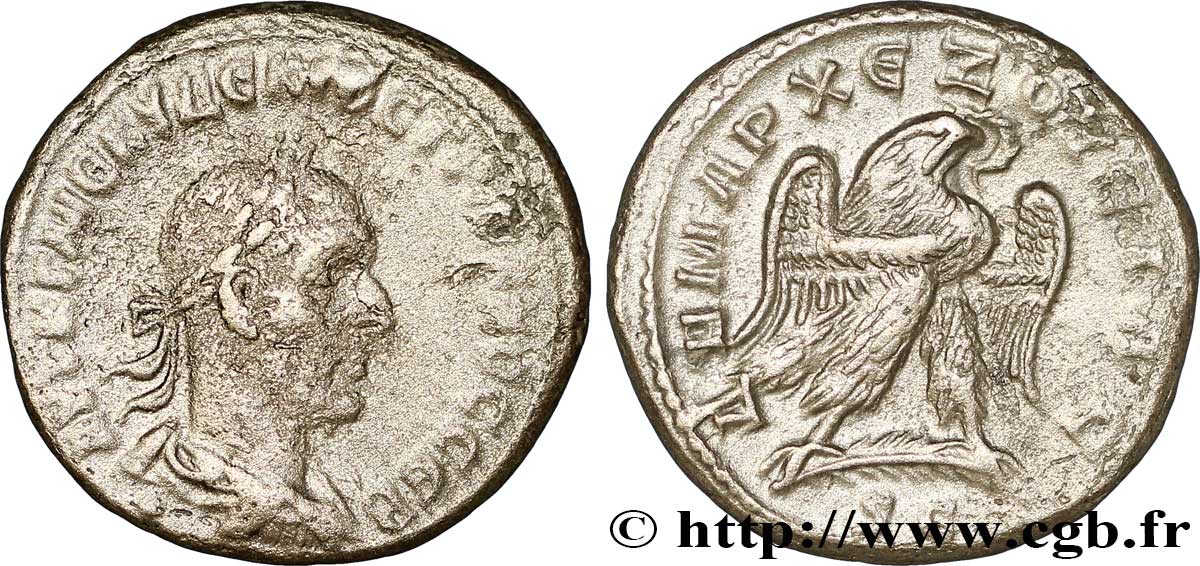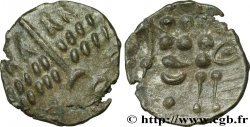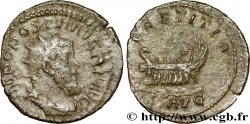E-auction 154-92391 - bpv_154343 - TRAJAN DECIUS Tétradrachme syro-phénicien
You must signin and be an approved bidder to bid, LOGIN TO BID. Accounts are subject to approval and the approval process takes place within 48 hours. Do not wait until the day a sale closes to register. Clicking on « bid » constitutes acceptance of the terms of use of cgb.fr private e-auctions.
Bids must be placed in whole Euro amounts only. The sale will start closing at the time stated on the item description; any bids received at the site after the closing time will not be executed. Transmission times may vary and bids could be rejected if you wait until the last second. For further information ckeck the E-auctions F.A.Q.
NO BUYER'S FEE.
NO BUYER'S FEE.
| Estimate : | 70 € |
| Price : | 34 € |
| Maximum bid : | 35 € |
| End of the sale : | 28 March 2016 15:15:00 |
| bidders : | 6 bidders |
Type : Tétradrachme syro-phénicien
Date: 250
Mint name / Town : Antioche, Syrie, Séleucie et Piérie
Metal : billon
Diameter : 28 mm
Orientation dies : 12 h.
Weight : 11,27 g.
Coments on the condition:
Très légère usure, patine légère mais très sombre
Catalogue references :
Predigree :
Cet exemplaire est le 0523_005 de la base TSP et provient des plateaux de Girardi en 1998
Obverse
Obverse description : Buste lauré, drapé et cuirassé de Trajan Dèce à droite, vu de trois quarts en arrière (A*2), un globule sous le buste.
Obverse legend : AUT K G ME KU DEKIOS TRAIANOS SEB
Obverse translation : (L’empereur césar Caius Messius Quintus Dèce Trajan auguste).
Reverse
Reverse legend : S C À L’EXERGUE.
Reverse description : Aigle debout à gauche sur une palme, les ailes déployées, tête à gauche et queue à droite, tenant une couronne feuillée dans son bec.
Reverse legend : DHMARC EX OUSIAS
Reverse translation : (Revêtu de la puissance tribunitienne / avec l’accord du Sénat d’Antioche).
Commentary
Le gros des émissions de Trajan Dèce porte une titulature avec son nom (Dèce) et son surnom adopté (Trajan). Ces émissions se répartissent sur deux années que l’on distingue par l’ordre nom/surnom dans la titulature. Nous connaissons l’ordre par comparaison avec les émissions d’Alexandrie où la même inversion se produit dans la titulature mais où les frappes sont datées (1ere ou 2e année).
Comme pour les émissions inaugurales, l’exergue ANTIOXIA des 3e et 4e consulats de Philippe disparait et est remplacée par la palme, en usage avant le troisième consulat de Philippe. Faut-il en déduire que le financement des émissions changea et retourna aux autorités provinciales alors qu’elles auraient été assumées par la ville durant les 3e et 4e consulats de Philippe ? Il faut se rappeler que le frère de Philippe, Priscus, installé à Antioche pendant tout le règne avec tous les pouvoirs (y compris le titre de Rector Orientis !) avait peut-être obligé la ville à financer les émissions monétaires ; la source de son pouvoir disparue (on ignore sa fin) on peut imaginer que la ville se débarrassa du fardeau qui revint donc aux nouvelles autorités provinciales, trop heureuses de manifester leur allégeance au nouveau pouvoir par des émissions monétaires à son effigie.
Le choix adopté dans le Prieur, mettre tous les bustes particuliers à part, quelque soit leur officine, rend la lecture des émissions difficile et ne serait plus adopté aujourd’hui, au profit d’un classement par officines.
En effet, si le buste type, lauré, drapé et cuirassé prédomine très largement, on ne peut percevoir la logique de gravure des bustes exceptionnels qu’en fonction de leur présence où non dans des officines. Ce reclassement devra être fait.
On note que les sigma sont gravés en C.
Dans la base TSP maintenue par Michel Prieur, trente cinq exemplaires sont maintenant répertoriés pour ce type dont en musées British Museum, Hunterian Glasgow, Jérusalem, ANS (4), Yale, Doura et Yale (5), et Gaziantep.
The bulk of Trajan Decius's issues bear a title with his name (Deceius) and his adopted nickname (Trajan). These issues are spread over two years, distinguished by the name/nickname order in the title.. We know the order by comparison with the Alexandria issues where the same inversion occurs in the title but where the strikes are dated (1st or 2nd year).
As with the inaugural issues, the ANTIOXIA exergue of Philip's 3rd and 4th consulates disappears and is replaced by the palm, in use before Philip's third consulate. Should we deduce from this that the financing of the issues changed and returned to the provincial authorities when they would have been assumed by the city during the 3rd and 4th consulates of Philip? It must be remembered that Philip's brother, Priscus, installed in Antioch throughout the reign with all the powers (including the title of Rector Orientis!) had perhaps forced the city to finance the monetary issues; the source of his power having disappeared (we do not know how it ended) we can imagine that the city got rid of the burden which therefore fell to the new provincial authorities, only too happy to show their allegiance to the new power by issuing monetary issues bearing his image.
The choice adopted in the Priory, to put all the particular busts apart, whatever their office, makes the reading of the emissions difficult and would no longer be adopted today, in favor of a classification by offices.
Indeed, if the typical bust, laureate, draped and armored predominates very largely, we can only perceive the logic of engraving exceptional busts according to their presence or not in workshops. This reclassification will have to be done.
Note that the sigmas are engraved in C.
In the TSP database maintained by Michel Prieur, thirty-five examples are now listed for this type, including in museums such as the British Museum, Hunterian Glasgow, Jerusalem, ANS (4), Yale, Doura and Yale (5), and Gaziantep.
Comme pour les émissions inaugurales, l’exergue ANTIOXIA des 3e et 4e consulats de Philippe disparait et est remplacée par la palme, en usage avant le troisième consulat de Philippe. Faut-il en déduire que le financement des émissions changea et retourna aux autorités provinciales alors qu’elles auraient été assumées par la ville durant les 3e et 4e consulats de Philippe ? Il faut se rappeler que le frère de Philippe, Priscus, installé à Antioche pendant tout le règne avec tous les pouvoirs (y compris le titre de Rector Orientis !) avait peut-être obligé la ville à financer les émissions monétaires ; la source de son pouvoir disparue (on ignore sa fin) on peut imaginer que la ville se débarrassa du fardeau qui revint donc aux nouvelles autorités provinciales, trop heureuses de manifester leur allégeance au nouveau pouvoir par des émissions monétaires à son effigie.
Le choix adopté dans le Prieur, mettre tous les bustes particuliers à part, quelque soit leur officine, rend la lecture des émissions difficile et ne serait plus adopté aujourd’hui, au profit d’un classement par officines.
En effet, si le buste type, lauré, drapé et cuirassé prédomine très largement, on ne peut percevoir la logique de gravure des bustes exceptionnels qu’en fonction de leur présence où non dans des officines. Ce reclassement devra être fait.
On note que les sigma sont gravés en C.
Dans la base TSP maintenue par Michel Prieur, trente cinq exemplaires sont maintenant répertoriés pour ce type dont en musées British Museum, Hunterian Glasgow, Jérusalem, ANS (4), Yale, Doura et Yale (5), et Gaziantep.
The bulk of Trajan Decius's issues bear a title with his name (Deceius) and his adopted nickname (Trajan). These issues are spread over two years, distinguished by the name/nickname order in the title.. We know the order by comparison with the Alexandria issues where the same inversion occurs in the title but where the strikes are dated (1st or 2nd year).
As with the inaugural issues, the ANTIOXIA exergue of Philip's 3rd and 4th consulates disappears and is replaced by the palm, in use before Philip's third consulate. Should we deduce from this that the financing of the issues changed and returned to the provincial authorities when they would have been assumed by the city during the 3rd and 4th consulates of Philip? It must be remembered that Philip's brother, Priscus, installed in Antioch throughout the reign with all the powers (including the title of Rector Orientis!) had perhaps forced the city to finance the monetary issues; the source of his power having disappeared (we do not know how it ended) we can imagine that the city got rid of the burden which therefore fell to the new provincial authorities, only too happy to show their allegiance to the new power by issuing monetary issues bearing his image.
The choice adopted in the Priory, to put all the particular busts apart, whatever their office, makes the reading of the emissions difficult and would no longer be adopted today, in favor of a classification by offices.
Indeed, if the typical bust, laureate, draped and armored predominates very largely, we can only perceive the logic of engraving exceptional busts according to their presence or not in workshops. This reclassification will have to be done.
Note that the sigmas are engraved in C.
In the TSP database maintained by Michel Prieur, thirty-five examples are now listed for this type, including in museums such as the British Museum, Hunterian Glasgow, Jerusalem, ANS (4), Yale, Doura and Yale (5), and Gaziantep.








 Report a mistake
Report a mistake Print the page
Print the page Share my selection
Share my selection Ask a question
Ask a question Consign / sell
Consign / sell
 Full data
Full data















